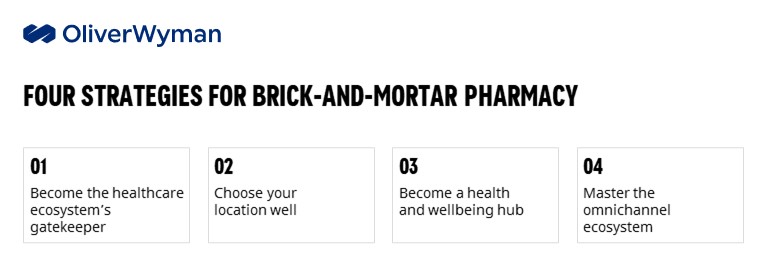Brick-and-mortar pharmacies are not immune from the same challenge facing the rest of healthcare: How to meet the increasing consumer demand for virtual touchpoints and convenience. They’re well-accustomed to living in a world – especially in the pandemic – where interactions are more virtual by default. Consumers now want the same process from their pharmacy.
Virtual or bust reigns. And as consumer demand for this level of interaction grows, we expect to see a more integrated and seamless system emerge. Just like bank branches are losing their customer base as most interactions have been digitized or automated, brick-and-mortar pharmacies face the risk of extinction if they remain status quo and do not offer relevant in-person and virtual services.
Alexa, How’s My Health Today? Can You Send Me My Pills?
To transform this space, pharmacy disruptors will have to create multi-channel approaches, which are still rare in Europe. But we are seeing some pockets of innovation. Consider the Swiss company ZurRose (owner of the DocMorris Mail pharmacy in Germany). They have a digital ecosystem in collaboration with health insurances in Switzerland. They also acquired a German telemedicine start-up to channel consumers to their offerings, providing a seamless service. Additionally, ZurRose is moving into the brick-and-mortar space with store-in-store concepts in collaboration with one of Switzerland’s largest grocery chains.
The collaborative efforts have room to grow and generate more profits but are examples of how innovation can begin to spread across the sector. And as companies like Amazon—whose pharmacy business is still cross financed by other Amazon business units—continue to enter the space, we are likely to see even more disruption.
There are cases where such digital operations are profitable. In Sweden, 50% of online orders for pharmacy goods are bought through Apotea, which runs profitable. Even incumbents have cracked the code: one of the large Swedish brick-and-mortar operators Apoteket Hjärtat, owned by ICA, the large grocery retailer, has established an e-commerce and telehealth ecosystem which has run profitably in Q4 of 2021 with a multi-channel approach.
Accelerating the Journey Toward Digital
Sustaining this level of disruption though will require modernizing regulatory frameworks. Where pharmacy markets have been liberalized, we observe an increased push towards digitalization and other efficiencies. The result is patients and consumers end up paying less for their care delivery, with better digital interfaces. The question remains therefore: For how long are non-liberalized markets like Germany – which has a higher density of pharmacies per population than other neighboring liberalized countries – willing to pay a higher price for pharmacy products and services?
Four Key Considerations for Next Steps
A prerequisite that will raise in importance is knowing your customers’ needs and tailoring your offering. Is it acute or chronic? Is choice driven by convenience or clinical needs? In an attempt to find solutions and answers to questions such as these, we know one thing for sure regarding the future truths for brick-and-mortar pharmacy: To truly thrive in time, this industry sector must become both health providers and part of the greater digital ecosystem. On that note, here are four strategies on how to thrive going forward:

1. Become the gatekeeper to the healthcare ecosystem: Offer basic care and diagnosis services and become a gatekeeper to specialist physicians. This model has been already established in Switzerland in collaboration with some health insurance plans. The key to success in this field is the willingness to reimburse for such services by payers and/or consumers.
2. Choose your location well: With the right location choice, pharmacies can control the product and volume mix of their sales. Locations inside health clinics will ensure a continuous supply of prescriptions to fill (locations close to specialist practices in Germany will ensure the sale of high-value prescription drugs). Locations in more commercial environments will drive non-prescription sales. The right choice will depend on legislation and reimbursement practices in the respective country.
3. Become a health and wellbeing hub: In the age of the measured self, no incumbent organization has yet taken the baton in offering advice and tailor-made products to this demographic. The current offering in pharmacies is usually limited to an assortment of vitamins and skincare. The pharmacy of the future pursuing the health and wellbeing play will offer advice on everything from nutrition and fitness to genomics with the appropriate individualized products. Many pharmacies already offer multi-pack blistering drugs, so why not vitamins according to the genomic fingerprint?
4. Master the Omni-channel ecosystem: As the case of ICA’s Apoteket Hjärtat shows in Sweden, incumbent brick-and-mortar operators can innovate in the omnichannel space and be successful. This not only requires scale, but also a higher sophistication in pricing, assortment mix, and a continuous cost-optimization effort.
Three Questions to Consider Next
The above strategies will be highly dependent on three factors and may vary country by country.
1. The first is what is the legislation in the respective country for pharmacy liberalization and online B2C (business-to-consumer) sales for prescription and non-prescription pharmacy products?
2. The second factor is if the respective country has a digital ecosystem that allows Omni-channel approaches (e-prescriptions and E-IDs), the Netherlands and England are examples of countries which have the lead in this area.
3. The third factor is are the payers in the respective health systems willing to collaborate with pharmacy operators in a partnership vs. the legacy model of checks and oversight?
Making questions like these actionable agenda items will lead to an improved healthcare industry where tech-savvy and tech-comfortable consumers’ needs are met and exceeded by the pharmacy industry to come.
